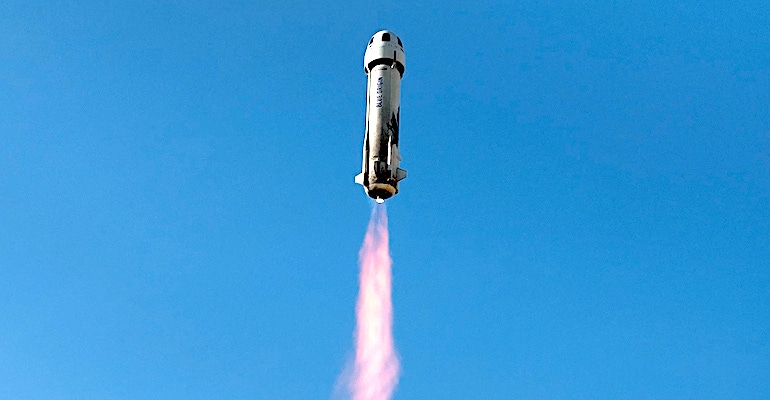FAA Closes Blue Origin Launch Investigation
The FAA has released its requirements for Blue Origin to resume New Shepard flights following last year’s failure.

Almost exactly a year after the New Shepard booster failure that triggered an emergency abort and separation of the cargo capsule during a Blue Origin launch, the Federal Aviation Administration has released its findings on the mishap.
Because of the structural failure of an engine nozzle due to higher-than-expected engine temperature, there was a thrust misalignment, as the booster’s good engines continued to deliver normal power. This automatically triggered the booster’s shutdown and the simultaneous activation of the Crew Capsule escape system.
It was a good indication of what human crews can expect in the event of a launch problem, though this was a cargo-only mission with no people aboard. The capsule and the cargo aboard were not only undamaged, but Blue Origin intends to launch them again atop a new booster.
It was reminiscent of the 2018 Soyuz MS-10 failure of a crewed launch from Baikonur Cosmodrome in Kazakhstan that was caused by the failure of a sensor used to trigger liquid oxygen vent valves that permit a clean separation of the Soyuz rocket’s external boosters from the core stage. The two crew members aboard landed safely after experiencing very high g-levels from the separation and reentry.
SpaceX conducted a test of the abort system on the Falcon 9 as that company prepared the Dragon capsule for crewed flight in 2020. SpaceX’s booster and capsule passed that test as a final milestone toward crewed missions.

For Blue Origin to resume New Shepard flights, the FAA identified 21 changes needed to prevent future such mishaps, including the redesign of engine and nozzle components to improve structural performance during operation as well as organizational changes.
The FAA said: “The closure of the mishap investigation does not signal an immediate resumption of New Shepard launches. Blue Origin must implement all corrective actions that impact public safety and receive a license modification from the FAA that addresses all safety and other applicable regulatory requirements prior to the next New Shepard launch.”
Blue Origin’s Mishap Investigation Team began testing the BE-3PM engine immediately following the mishap and established that the flight configuration of the nozzle operated at hotter temperatures than previous design configurations.
The company reported that forensic evaluation of the recovered nozzle fragments also showed clear evidence of thermal damage and hot streaks resulting from increased operating temperatures and that the fatigue location on the flight nozzle aligned with a persistent hot streak identified during the investigation.
The team found that design changes made to the engine’s boundary layer cooling system accounted for an increase in nozzle heating and explained the hot streaks present. As a result, the company has made design changes to the combustion chamber and has changed the booster’s operating parameters to reduce engine nozzle bulk and hot-streak temperatures. Additional design changes to the nozzle have improved structural performance under thermal and dynamic loads.
While the FAA cautioned that the release of the report “does not signal an immediate resumption of New Shepard launches,” Blue Origin has been working to apply the required changes already, so the rocket should be cleared to fly soon. This was the implication of Blue Origin’s reply to the FAA’s post on Twitter/X only 12 minutes later, declaring the company’s intent to fly “soon.”
About the Author(s)
You May Also Like


.jpg?width=300&auto=webp&quality=80&disable=upscale)


